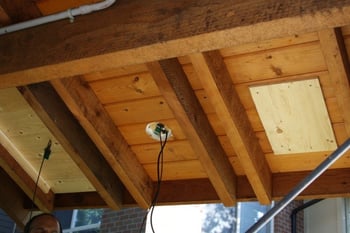 Attic ventilation is a firmly established requirement for residential wood-framed buildings. Attic ventilation is cited to be a benefit for moisture control, reducing cooling loads in hot climates, minimizing ice dams in cold climates, and extending the service life of roof materials by reducing surface temperatures. There is an ongoing
Attic ventilation is a firmly established requirement for residential wood-framed buildings. Attic ventilation is cited to be a benefit for moisture control, reducing cooling loads in hot climates, minimizing ice dams in cold climates, and extending the service life of roof materials by reducing surface temperatures. There is an ongoing  debate on the real significance of some of these benefits and mandatory venting requirements. Despite plenty of attention to moisture control and ventilation of attics, there is growing evidence that buildings, which are built to code in cool marine climates, have mold growth in attic spaces. Problems are being reported in marine climates in both Europe and North America.
debate on the real significance of some of these benefits and mandatory venting requirements. Despite plenty of attention to moisture control and ventilation of attics, there is growing evidence that buildings, which are built to code in cool marine climates, have mold growth in attic spaces. Problems are being reported in marine climates in both Europe and North America.
The objective of this paper is to demonstrate how cold attic spaces, which are subject to high outdoor moisture levels and are built to code (ventilation area and distribution and ceiling air tightness) can still have moisture problems and to identify the contributing factors leading to mold growth. This paper covers a study in British Columbia, Canada of four attics and a control roof at the same location but not over conditioned space. Testing and measurements included long-term monitoring, air leakage and venting area characterization using dual blower door fans, smoke testing, and tracer gas testing to measure air transfer rates.

